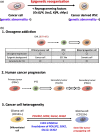Induced pluripotent stem cell technology for dissecting the cancer epigenome
- PMID: 26224327
- PMCID: PMC4638022
- DOI: 10.1111/cas.12758
Induced pluripotent stem cell technology for dissecting the cancer epigenome
Abstract
Cancer arises through the accumulation of both genetic and epigenetic alterations. Although the causal role of genetic mutations on cancer development has been established in vivo, similar evidence for epigenetic alterations is limited. Moreover, mutual interactions between genetic mutations and epigenetic alterations remain unclear. Cellular reprogramming technology can be used to actively modify the epigenome without affecting the underlying genomic sequences. Here we introduce recent studies that have utilized this property for cancer research. We propose that just as it has potential for regenerative medicine and disease modeling, cell reprogramming could also be a powerful tool for dissecting the role of the cancer epigenome in the development and maintenance of cancer cells.
Keywords: Cancer epigenetics; DNA methylation; cancer model; iPS cell; reprogramming.
© 2015 The Authors. Cancer Science published by Wiley Publishing Asia Pty Ltd on behalf of Japanese Cancer Association.
Figures




Similar articles
-
The causal relationship between epigenetic abnormality and cancer development: in vivo reprogramming and its future application.Proc Jpn Acad Ser B Phys Biol Sci. 2018;94(6):235-247. doi: 10.2183/pjab.94.016. Proc Jpn Acad Ser B Phys Biol Sci. 2018. PMID: 29887568 Free PMC article. Review.
-
[Application of reprogramming technology for cancer research].Nihon Rinsho. 2015 May;73(5):751-5. Nihon Rinsho. 2015. PMID: 25985626 Japanese.
-
Cellular reprogramming and cancer development.Int J Cancer. 2013 Mar 15;132(6):1240-8. doi: 10.1002/ijc.27963. Epub 2012 Dec 17. Int J Cancer. 2013. PMID: 23180619 Review.
-
Application of iPS cell technology to cancer epigenome study: uncovering the mechanism of cell status conversion for drug resistance in tumor.Pathol Int. 2014 Jul;64(7):299-308. doi: 10.1111/pin.12180. Pathol Int. 2014. PMID: 25047500 Review.
-
Cellular reprogramming technology for dissecting cancer epigenome in vivo.Epigenomics. 2017 Jul;9(7):997-1011. doi: 10.2217/epi-2017-0018. Epub 2017 Jun 27. Epigenomics. 2017. PMID: 28651445 Review.
Cited by
-
Current status in cancer cell reprogramming and its clinical implications.J Cancer Res Clin Oncol. 2017 Mar;143(3):371-383. doi: 10.1007/s00432-016-2258-5. Epub 2016 Sep 12. J Cancer Res Clin Oncol. 2017. PMID: 27620745 Free PMC article. Review.
-
An EWS-FLI1-Induced Osteosarcoma Model Unveiled a Crucial Role of Impaired Osteogenic Differentiation on Osteosarcoma Development.Stem Cell Reports. 2016 Apr 12;6(4):592-606. doi: 10.1016/j.stemcr.2016.02.009. Epub 2016 Mar 17. Stem Cell Reports. 2016. PMID: 26997645 Free PMC article.
-
The causal relationship between epigenetic abnormality and cancer development: in vivo reprogramming and its future application.Proc Jpn Acad Ser B Phys Biol Sci. 2018;94(6):235-247. doi: 10.2183/pjab.94.016. Proc Jpn Acad Ser B Phys Biol Sci. 2018. PMID: 29887568 Free PMC article. Review.
-
Human pluripotent stem cell-derived models and drug screening in CNS precision medicine.Ann N Y Acad Sci. 2020 Jul;1471(1):18-56. doi: 10.1111/nyas.14012. Epub 2019 Mar 15. Ann N Y Acad Sci. 2020. PMID: 30875083 Free PMC article. Review.
-
Exploring the promising potential of induced pluripotent stem cells in cancer research and therapy.Mol Cancer. 2023 Nov 28;22(1):189. doi: 10.1186/s12943-023-01873-0. Mol Cancer. 2023. PMID: 38017433 Free PMC article. Review.
References
-
- Vogelstein B, Kinzler KW. Cancer genes and the pathways they control. Nat Med. 2004;10:789–99. - PubMed
-
- Jones PA, Baylin SB. The fundamental role of epigenetic events in cancer. Nat Rev Genet. 2002;3:415–28. - PubMed
-
- Hattori N, Ushijima T. Compendium of aberrant DNA methylation and histone modifications in cancer. Biochem Biophys Res Commun. 2014;455:3–9. - PubMed
-
- Feinberg AP, Vogelstein B. Hypomethylation distinguishes genes of some human cancers from their normal counterparts. Nature. 1983;301:89–92. - PubMed
Publication types
MeSH terms
LinkOut - more resources
Full Text Sources
Other Literature Sources

